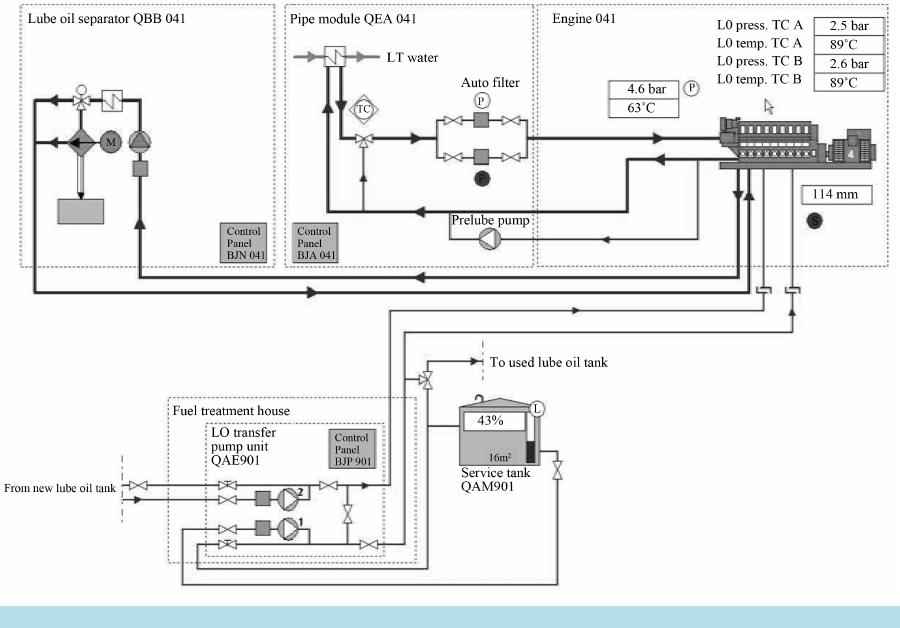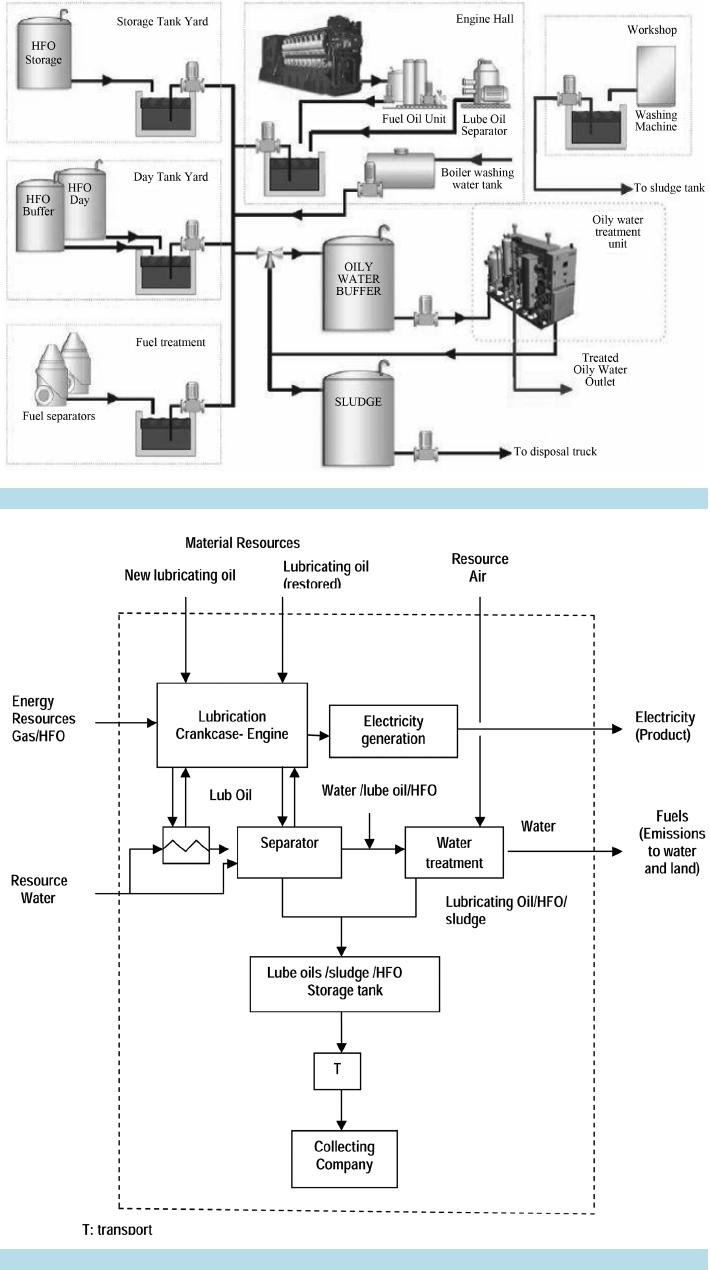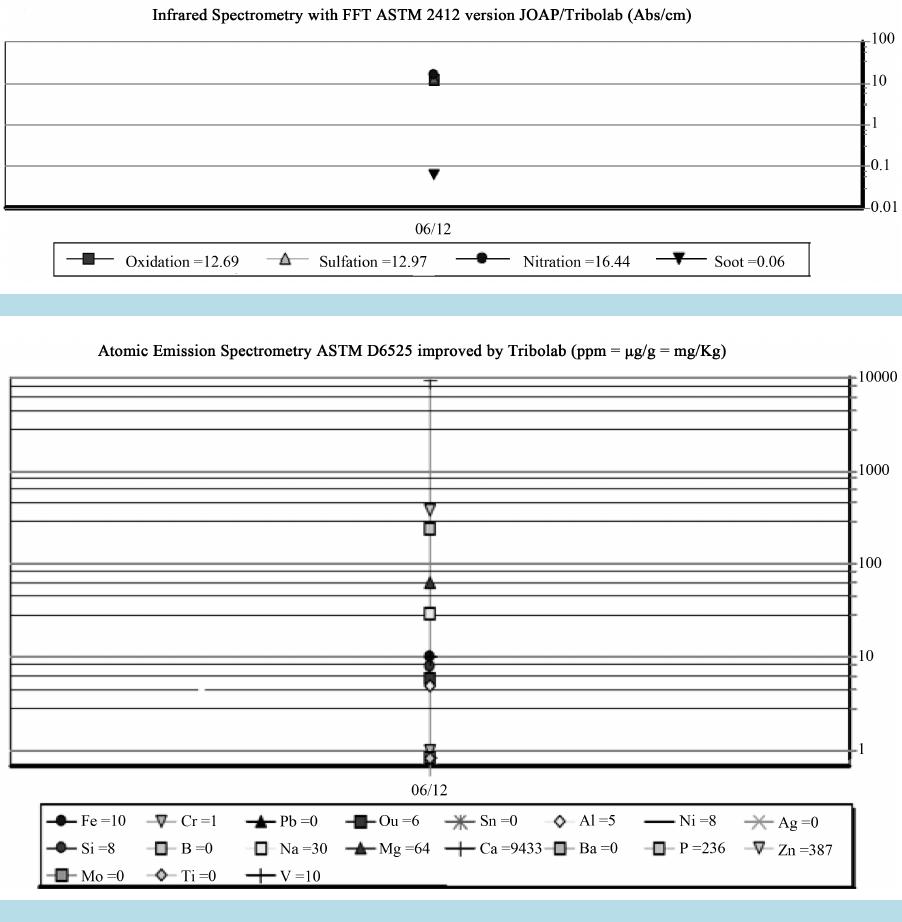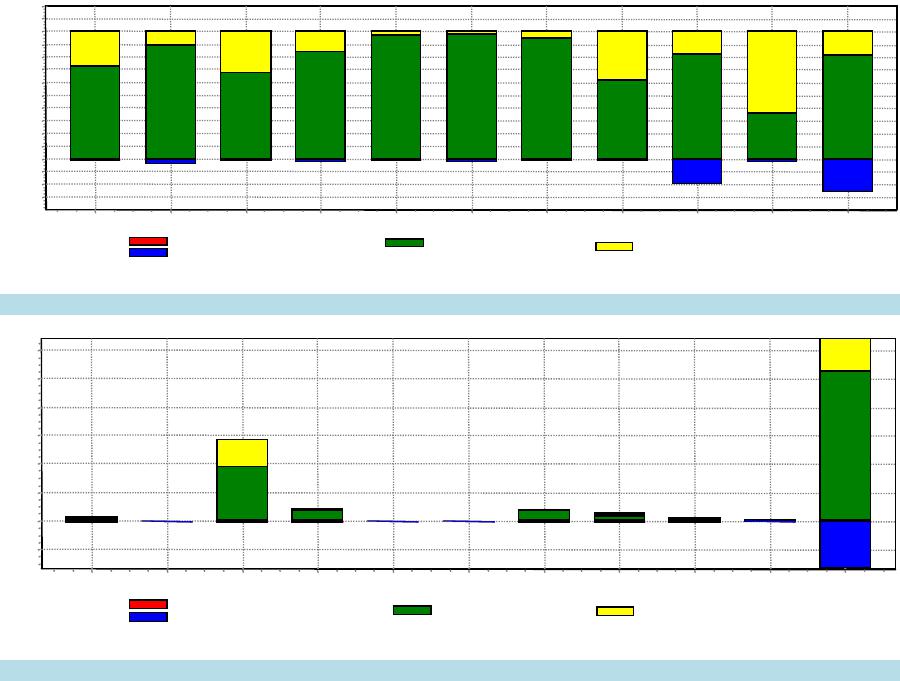 Open Access Library Journal How to cite this paper: Touset, J.-P. H. (2014) An Approach for Life Cycle Assessment of Electricity Generation at Gas-HFO Internal Combustion Engines in a Central Station. Open Access Library Journal, 1: e765. http://dx.doi.org/10.4236/oalib.1100765 An Approach for Life Cycle Assessment of Electricity Generation at Gas-HFO Internal Combustion Engines in a Central Station Juan-Pedro Hernández Touset1, Jandecy Cabral Leite2, Iván-Leandro Rodríguez Rico1, Alcimar de Jesus França3, Elena-Rosa Dominguez1, Oiama de Assis Guedes3, Italo-Jorge Tavares Jimenez2, Arnaldo Herrera Artiles1, Maylier Pérez Gil1 1Universidad Central “Marta Abreu” de Las Villas, Santa Clara, Cuba 2ITEGAM-Instituto de Tecnologia e Educação Galileo da Amazônia, Manaus, Brasil 3Companhia Energética Manauara S.A., Manaus, Brasil Email: juanpedro@uclv.edu.cu, jandecycabral@hotmail.com, alcimarfranca@utemanauara.com.br Received 5 July 2014; revised 10 August 2014; accept ed 15 September 2014 Copyright © 2014 by authors and OALib. This work is licensed under the Creative Commons Attribution International License (CC BY). http://creativecommons.org/licenses/by/4.0/ Abstract This paper applies the Life Cycle Assessment (LCA) as an assessment tool to quantify the environ- mental impacts associated with electricity generation by internal combustion engines. Steps, re- sources and/or supplies that have the greatest impacts during the life cycle of electricity generation are identified to contribute with measures of cleaner production in companies with similar power generation. The goal of this study is to evaluate the environmental impacts associated with the production of 1552 kWh of electricity by gas-HFO internal combustion engines, considering a sce- nario that responds to use of lubricating oil, oily water treatment, collection and transportation of sludge. The study of additives and contaminants from lubricating oil is included, taking into account that it is a complex task for life cycle inventory considering limitations to get data. Arising from the use of the program SimaPro we get that the greatest impact are the lubricating oil use and transport on respiration of inorganic products and the use of fossil fuels. Most environmental impacts are concentrated in the use of lubricating oil and transportation. Keywords Additives, Internal Combustion Engines, Life Cycle Assessment, Lubricating Oil Subject Areas: Chemical Engineering & Technology, Environmental Sciences J.-P. H. Touset et al. DOI:10.4236/oalib.1100765 2 September 2014 | Volume 1 | e 1. Introduction The gas power plants are designed for optimal operation in a wide variety of decentralized energy production, among these, stationary plants. The motors are designed for continuous operation mode, natural gas or dual fuel gas and High Fuel Oil. The company sets its own environmental policy and operates in accordance with the principles of sustainable development, however, and industrial emissions and waste from maintenance of the engines do not express the absolute truth of the environmental impacts [1]. The Life Cycle Assessment (LCA) applied at a power plant may have several benefits; its use for assessing the environmental impact of electricity generation may help to compare types of lubricants and fuels in engines and to assess lube and wastes impact. In conventional thermal energy conversion in power plants, impacts connected to constructing the power plant or manufacturing the equipment are not important for the overall environmental impact of the electricity pro- duced. A la r ge po rtion of the environmental impact is connected to the production of electricity [2]. Primary life cycle inventory of the different types of lubrica ting oil additives , obtained fro m lab chemica l and physical analysis is a good tool for assessing the environmental impact of lubricants and wastes. The novelty of this study lies on the information provided by the lubricating oil composition, sludge and waste water for further applicat ion of LCA methodol ogy w i t h e xtended b o undaries . In researching the environmental impact of lubricants, Wissol Autoexpress [3] considered the end of the lu- bricants life cycle, as the key stage for identifying the problems that may occur during the handling and disposal of used oil-based lubricants. For the LCA of the studied product, the information of the energy used and emis- sions generated by the different agents is required, which implies in most cases working with data from different and not homogeniz e d sources [4]. In this context, LCA methodolog y was applied to examine the role of lubricating oil on electricity generation and the effect of considering its consumption in process equipments. The present study aimed to contribute to a better understanding of the influence of material and processes involved at a power plant in the results of LCA. Based on potential impacts on human health and the environment, re-refining and distillation ar e significantly better practices than burning used oil as fuel [5]. From the environmental standpoint [6], the collection and sto- rage of used lubricating oil (with subsequent regeneration of the lubricating oil by catalytic hydrogenation) re- duces the environmental deterioration as it reduces th e effects of incineration (air emission s) of used lubricating oil and unc o ntrolle d di s c harge (w a t e r, soil cont a minati on a n d gr oundwat e r). The functional processes are also a problem for the LCA because not all functional flows are usually part of the same product system. Thus, a multifunctional process is part of the studied production system and of other systems too. The challenge is to allocate the environmental impacts of this process to the different multifunc- tional product systems, i.e. to the different functional flows [7]. The most frequently used methods for solving this problem are subdivision, system expansion, physical and economic partition and replacement. Several au- thors have argued that replacement is conceptually equivalent to system expansion [8] [9]. The energy in the form of electricity is an important input into many industrial processes, and as there are several alternatives for energy production, many LCAs on electricity production have been carried out at nu- merous institutes and companies throughout the world [10]. This research focuses on lubricating oil subsystem and the generated electricity as the output product to technosphere. Used lubricating oil su bsystem is not consi- dered. On the other hand, taking into consideration the LCA benefits related with the incorporation of different types of lubricating oil additives , it was necessary to review some important theoretica l views on this topic. The addi- tives are substances formulated to enhance antifriction properties, chemical and physical properties of base oils (mineral, synthetic, vegetable or animal) which result in improved performance of the lubricant and so the equipment life extension. The amount of additives may be up to 30% [11]. The additives have different functions and usually belong to the categories of friction modifiers (Graphite, Molybdenum Disulfide, Boron Nitride, Tungsten Disulfide, Polytetrafluoroethylene), antiw ear (Zinc Dith iopho- sphate (ZDP), Zinc Dialkyl Dithiophosphate, Tricresyl), extreme pressure additives (chlorinated paraffins, sulfur fats, Esters, Zinc Dialkyl Dithiophosphate, Molybdenum Disulfide); rust and corrosion inhibitors (alkaline compounds, organic acids, esters, amino-acid derivatives ), antioxidants (Zinc Dithiophosphate, alkyl sulfides, aromatic sulfides, aromatic amines, hindered phenols), detergents (phenolates, sulfonates and phosphonates of J.-P. H. Touset et al. DOI:10.4236/oalib.1100765 3 September 2014 | Volume 1 | e alkali and alkaline-earth elements such as calcium, magnesium, sodium or barium); dispersants (Polyisobutylene Succinimides) pour point depressants (Polyalkyl Methacrylate Copolymers ) viscosity index improvers (Poly- meric Acrylate) and antifoamin g agents (Dimethylsiloxanes). Raimondi [12] integrates and expands the previous LCAs of oil-based lubricants and also examines the addi- tives contribution of a fully formulated lubr icant to the environmental im pact. In this case, the additive con tribu- tion to the life cycle impacts o f commercial lubricating oil was found to be nearly 35% to global warming. The main sources of data for the LCA were the Boustead Model [13], Ecoinvent [14], European Reference Life Cycle Database-ELCD [15] and the report IFEU/GEIR [16]. The last one reports that the composition of lubri- cating oil ca n be 80% of oil-based lubricants (mineral/synthetic), 2% of detergents, 6% dispersants, 9% viscosity modifiers (olefin copolymers), 1% antioxidant (Zinc Dialkyl Dithiophosphates/Phenols) and 2% antiwear (Zinc Dialkyl Dithiophosphates). LCA models proposed phases include extraction, transportation and production to the output of the refinery/fa ctory. The allocation criterion for th e outputs is mass. The main conclusion is th at in modern lubricants, additives contribution in terms of environmental impact can be significantly high and there- fore should not be excluded. Ekman and Börjesson [17] admit that in applications where the amount of additives can be up to 30%, the environmental consequences are significant and ultimately recommend to include addi- tives in future LCAs. Since new components of lubricating oils blended with conventional additives are emerging there are not enough data for the implementation of LCA. On the other hand, manufacturers of additives and lubricants are extremely conservative and rarely are willing to provide data and information. This paper is structured as fol- lows. Firstly a critical analysis of the literature on various aspects related to the application of LCA is given. Then, the elements to be taken into account to define the goal and scope of the study and life cycle inventory for the environmental impact assessment are suggested, as well as a discussion on the availability and understanding of the data and the influence of additives on LCA for future research of alternative scenarios in the life cycle of used lubricating oils and oily wa s tes . The goal of this study was to assess the environmental impacts of electricity generation by natural gas-High Fuel Oil internal combustion engines, considering a scenario that responds to use of lubricating oil, oily water treatment, collection and transportation of sludge. Also the environmental profile of electricity generation sys- tem is examined using Eco-indicator 99 method to obtain the total contribution of the process for each one of the impacts categories in correspondence with the study conditions. 2. Materials and Methods The reason for analyzing the LCA of electricity generation is to provide the power plant with a systematic framework to identify, quantify, interpret and evaluate the environmental impacts of electricity generation from internal combustion engines. 2.1. Goals and Scope Definition The goal of this study is to assess the environmental impacts associated with the production of 1552 kWh of electricity by gas-HFO internal combustion engines, considering a scenario that responds to the use of lubricat- ing oils, oily water treatment, collection and transportation of sludge. As an analytical tool, LCA facilitates the information for decision-making and identification of opportunities for improvement. The analysis, evaluation and proposals for the application of LCA to lubricating oils are in corresponde nce with the standards of ISO 14 040, 14041, ISO 14042, and ISO 1404 3. 2.1.1. Function and Description of the Power Plant and the Lubricating Oil System The power plant has an installed capacity (total power of generation) of 85,380 kW, composed of 5 groups of Wärtsilä generators with an engine gas/HFO cycle of medium rotation, each of 17,076 kW continuous power at ISO conditions, at 514 rpm. The gas is carried directly by pipes to the engine hall from the supplier. The plant operates with a power demand of 63 MW, delivering 525,600 MWh/y of electric power, and consumes 11 310 MWh/year during 8700 h/year and a specific fuel consumption of 209 g/kWh. For engine lubrication the plant uses Marbrax CCD 430 mineral oil. Figure 1 shows the flowchart of the lubricating system. The oil is pumped back to the carter through a plate cooler. The centrifugal separator unit keeps the fuel and lubricant quality by removing water and sludge. 200 liters per day of lubricating oil is restored in the crankcase  J.-P. H. Touset et al. DOI:10.4236/oalib.1100765 4 September 2014 | Volume 1 | e Figure 1. Lubricating oil system. due to separation of sludge, burning in the engine jacket, saturation of the filter elements and other small losses. The process water is supplied from a well. The lubricating oil is supplied from a storage tank of 60 m³. In case of maintenance lubricating oil becomes reusable, and it is pumped to a service tank of 16 m3. A 30 m3 tank receives used motor lubricating oil. When the tank is full it is discharged into tank trucks of environmental companies. Figure 2 shows the oily water system. Oily water and sludge generated in the plant are stored in a box and separated into oily water and sludge. The water is sent to a processing unit by dissolved air flotation system. The treated water suitably mixed with other flows and effluents is discharged to the environment. Sludge and HFO (fuel) averaged 1000 kg/d are collected in a tank of 55 m3 and transported to a collector enter- prise. 2.1.2. Setting System Boundaries The system boundaries for the case study are in correspondence with those shown in Figure 3 by dashed lines. Multiple scenarios for lubricating oil treatment can be defined, and therefore the boundaries for the application of LCA may be different depending on the quality of data available for each option. The system, in general, starts with the use of lubric ating oil in the internal combustion engines. In the setting boundaries stage, electric- ity generation is defined as the main system and o il cleaning in the separation unit and the oily water tre atment is considered a subsystem. Therefore it is necessary to know the operations of the lubricating system and materials and energy flow be- tween them. For doing this the process tree is designed and it is represented in Figure 3, which shows the life cycle model for electricity generat i on used in a p ow er plant . 2.1.3. Allocation Rule of Environmental Loads and Main Assumptions In the lubrication stage an environmental load distribution is applied as function of mass percent that represents each output stream of the stage regarding to the total. The environmental load allocation is performed in order to evaluate the actual impact of the stream involved in the analysis; in the study the allocation criterion is mass. The main product is the electric energy.  J.-P. H. Touset et al. DOI:10.4236/oalib.1100765 5 September 2014 | Volume 1 | e Figure 2. Diagram of oily water collectio n an d tr eat ment unit. Figure 3. Process tree. J.-P. H. Touset et al. DOI:10.4236/oalib.1100765 6 September 2014 | Volume 1 | e The avoided product is considered the mixture sludge/HFO by replacing the use of Diesel in combustion at industrial plants. The adopted assumptions during the study are listed below: -It has been established as a functional unit an amount of 1512 MWh/day. -Sludge/HFO is considered avoided products, since they avoid the use of equivalent amounts of Diesel for combustion in industrial plants. -Exhaust gases are excluded. -Production of lubricating oil, maintenance and solid waste are not considered, but these may be included in other studies. -Systematic chemical analyses for evaluating the oil type and concentration of additives in the databases are carried out. -Mass balance results for the lubricating and oily water treatment system are used. -Impact assessment is carried out without including consumed electricity a t lube oil separators, since electric- ity is produced by the power plant. -Transportation of 20 tons of sludge/HFO in tanker trucks, traveling 40 Km every 20 days. 2.2. Life Cycle Inventory In the lubricating and oily water system, primary data were taken from operating reports, literature and special- ists’ criteria. It has been considered that the data meet the quality indicators for a proper interpretation of LCA results and has been kept in mind: 1) validity of the data (temporary), which correspond to the same year in implementing the L CA; 2) geographical coverage, where the data correspond to an operating plant; 3) accuracy, since the work has been done with the extreme value when the data match a range of values and 4) representativeness, since process-specific database are used, database and referenced literature are also used, considered a mature and modern technology. 2.3. Life Cycle Impact Assessment Methodology of Eco-indicator 99 for the assessment of environmental impacts is applied, using the SimaPro 6.0 software. 11 impact categories considered in the Eco-indicator 99 are assessed with weighting based on the hie- rarchical cultural perspective (Eco-indicator 99 (H) V2.1/Europe EI 99 H/H). These categories are related with three damage categories (human health, ecosystem quality and resources) [18]-[22]. Materials, resources and products used in the assessment were taken from Ecoinvent database, devel- oped by Ecoinvent Center, Swizerland. 2.4. Study Interpretation The whole system analysis, weak points and better alternatives were determined from the environmental point of view. As results of the evaluation, the final contribution of the inventory data, the network process, environ- mental profiles in impact and damage categories in tabular and graphical form were obtained, allowing deter- mining the stages and most striking system. 3. Results and Discussion 3.1. Analysis of Life Cycle Inventory In correspondence with SimaPro software, the categories for the inventory data are: -Inputs from the Ecosphere (natural resources). -Inputs from Technosphere (products, resources, human activity). -Outputs to Technosphere (products, by-products). -Ecosphera Emissions (emissions). Table 1 shows the results of physical and chemical analyses to th e treated water discharged into the water/so il [23], where the most significant value is the concentration of oils and fats.  J.-P. H. Touset et al. DOI:10.4236/oalib.1100765 7 September 2014 | Volume 1 | e Table 1. Results of physical and chemical analyses to the treated water discharged into the water/soil (MICRO-LAB, 2012). Parameters Unit Sample M.P.V. COD mg O2/L 139.0 N.A. Total phenols mg C6H5OH/L 0.00 up to 0.5 Phosphorus mg P/L 2.8 N.A. Nitrate mg N/L 1.4 N.A. Nitrite mg N/L 0.00 N.A. Oil and Fats mg /L 17.00 up to 20.0 Dissolved oxyge n mg O2/L 3.1 N.A. Settleable solids mg/ L <1.00 Up to 1.0 Dissolved solids mg/L 350.00 N.A. Suspended soli ds mg/L 26.00 N.A. Sulfites mg S/L 0.47 up to 1.0 Sulfates mg SO4/L 15.00 N.A. Turbidity NTU 32.00 up to 100.0 Temperature ˚C 31.00 N.A. M.P.V.: Maximum permissible values by article 16 of resolution CONAMA 430 of May 1 3 , 2011. N.A.: Not applicable. Lubricating Oil Additives Due to the absence of specialized literature on the topic and the low availability of primary data, a simplified methodology is adopted [12] to carry out the LCA considering the impact of the additives in the lubricant and wastes. It involves: 1) Identification of the category of the additive used in lubricating oil: lubricating oil Marbrax CCD 430 has antioxidant, anti-corrosion, anti-wear, anti-foam, detergent, dispersant, alkaline reserve agent and pour point de- pressant [24] (LUBRAX, 2011) and additives to 14% [25]; 2) Selection of a representative additive for each category, which can be taken from physical and chemical analysis results; 3) Identification of the correspondence between the selected additive and the industrial product available in the database Ecoinvent Data V 1.01 [14]. Figure 4 shows the chemical analysis resu lts to the lubricating oil Marbrax CCD 430 using infrared spectro- metry with ASTM E2412 FFT version JOAP/Tribolab [26] and Fig ure 5 shows the physical-chemical analysis results of the lubricating oil using ASTM D6525, atomic emission spectrometry improved by Tribolab, which determines the wear particle conc entration (Fe, Cr, Sn, Al, Ni, Cu, Pb, Mo), add itives concetration (Ca, Mg, B, Zn, P, Ba) and contaminants con centration (Si, Na, Va). The last one with low variation bu t of great importance in diagnoses since it can provide information regarding the composition of the waste oil and sludge. Corresponding to Figures 4, Figure 5 and Table 1 [23], the information provided by FDSPQ [25] and a sludge analysis report (HFO) from Intertek [27], Table 3 summarizes the main data and assumptions for addi- tives, contaminants and wastes. In this analysis a representative additive for each category of additive and con- taminants is adopted, which subsequently allows identifying the chemical in the software database. Table 2 shows the concentrations and the amount of additives and contaminants and also the concentration and amount of oil and grease in wastewater that is discharged into the environment, according to the analysis. Table 3 reports the results of inventory data of all stages according to the inventory categories. The inputs and outputs of process stages were inventoried in correspondence to the mass and energy balances, indexes reported in the literature and previous studies . 3.2. Life Cycle Impact Assessment In this section results for life cycle inventory assessment previously showed are discussed.  J.-P. H. Touset et al. DOI:10.4236/oalib.1100765 8 September 2014 | Volume 1 | e Figure 4. Infrared spectrometry to marbrax CCD 430 lubricating oil. Figure 5. Atomic emission spectrometry to marbrax CCD 430 lubricating oil. 3.2.1. Characterization In Figure 6 the characterization of the system express the percentages (%) each material represents for impact categories (carcinogenesis, organic compounds respiration, inorganic compounds respiration, climate change, radiation, ozone layer, ecotoxicity, acid ification/eutrophication, land use, miner als and use of fossil fuels) with- out considering electric consumption at lubricating oil separators. The contribution of lubricating oil, considered as an input in the sys tem boundaries established to the LCA is high and the contribution of transport is lower. In the categories of radiation, ozone layer, ecotoxicity and respiration of organics, lubricating oil contributes in more than 90% to the environmental impact. It is logical that the categories with the most impact are ozone layer, radiation, ecotoxicity, and respir ation of organics and the use of fossil fuels. 3.2.2. Weighting Materials weighting is analyzed in Figure 7 without considering electric consumption at lubricating oil separa-  J.-P. H. Touset et al. DOI:10.4236/oalib.1100765 9 September 2014 | Volume 1 | e Table 2. Main suppositions and data for LCA at power plant. Category Per cent (%) Concentration (mg/kg) Quantity (kg/1000 kWh) ADDITIVES Oíl-based lubricant 86 Antioxidant (Zinc dialkyldithiophosphate) 14 387 0.0195 Corrosion inhibi tor (Zi nc dialkyldithiophosphate) Anti-wear Antifoaming agent Detergent (Calcium alkylbencesulphonate) 9433 0.475 Dispersant alkaline reserve agent pour point depressants CONTAMINANTS - Silica 8 0.0004 Sodium 30 0.015 Vanadium 10 0.005 WASTES Oil and fats in waste water 17 0.000028 Sludge: Residual carbon conradson 7.38% p 0.017 Asphaltenes 2.49% p 0.0060 Metals: - - Vanadium 31.8 0.0000077 Aluminium 485.0 0.000117 Silica 678.0 0.00016 Calcium 2487.0 0.00060 Aluminium + Silica 1163.0 0.00028 Sodium 235.0 0.0000568 Nickel 41.70 0.00001 Iron 28.80 0.0000069 Table 3. Life cycle inventory. Known outputs to t echnosphere. Products and co-products Amount Unit Quantity Comments Electric energy 1512 MWh/d Energy Company handbook Known outputs to technosphe re. Avoided products Amount Unit Distribution Diesel 0.73 t/d Normal Operating reports Known inputs from nature (resources) Subcompartment Amount Unit Distribution Comments Process water 1.652 t/d Normal Operating reports Air 1.22 m3/d Normal Operating reports Lubricant oil 0.720 t/d Normal Operating reports Gas to engines 300 t/d Normal Operating reports HFO to engines 15.8 t/d Operating reports Emissions to water Subcompartment Amount Unit Distribution Hydrocarbons, non specified Water 0.000028 t/d Normal MICRO-LAB, 2012 Water 1.552 t/d Normal Mass balance  J.-P. H. Touset et al. DOI:10.4236/oalib.1100765 10 September 2014 | Volume 1 | e Figure 6. Environmental impacts without considering electric consumption at lubricating oil separators. Figure 7. Materials weighting on environmental impact categories. tors. It has been analyzed how each impact category is affected for all the materials involved in the electric gen- eration. It is noted again th at the biggest impact are the use of lubricating oil and transport on respiration of in- organic s as well as the us e of fossil fue ls. 3.2.3. Single Score Figure 8 shows the effect in Pt (impact points) that has the lubricating oil of internal combustion engines, transportation and damage avoided by reusing HFO and sludge wastes, on the 11 environmental impact catego- ries. A major influence is on the exhaustion of fossil fuels and respiration of inorganics in lubricating oil and transport. 4. Conclusions This study is a contribution in terms of the particularities to be taken into account in the steps of goal and scope of the study and in the step of life cycle inventory, which is brought to the power plant fundamental characteris- tics of LCA as an analytical tool for decision-making and the identification of opportunities for improvement. The contribution to the environ mental impact by materials indicates that the effect of the use of lubricating oil is minimal. A reference LCA Model and data for life cycle inventory is apported which can be examened in further studies. The impact evaluation of electricity generation system by means of Eco-indicator 99 and SimaPro software reported beneficial impacts on the carcinogenesis, radiation, ecotoxicity and land use categories, because of the reduction of emissions to the air, water and land by concept of avoided products. Most environmental impacts are concentrated in the use of lubricating oil and sludge transportation on respi- ration of inorga nics and the use of fossil fue ls. Analyzing 1.51E3 MWh “Produced energy without electricity”; Method: Eco-indicator 99 (H) V2.04 / Europe EI 99 H/H / Characterization Produced energy without electricityLubricant oil Transport, crude oil pipeline, offshore/OCE S Diesel, at refinery/RER S Carcinogens Resp. organicsResp. inorganicsClimate changeRadiation Ozone layerEcotoxicity Acidification / EutrophicationLand useMinerals Fossil fuels % 120 110 100 90 80 70 60 50 40 30 20 10 0 -10 -20 -30 Analyzing 1.51E3 MWh 'Produced energy without electricity'; Method: Eco-indicator 99 (H) V2.04 / Europe EI 99 H/H / W e i gh ting Produced energy without electricityLubricant oil Transport, crude oil pipeline, offshore/OCES Diesel, at refinery/RER S CarcinogensResp. organicsResp. inorganicsClimate changeRadiation Ozone layerEcotoxicity Acidification / Eutrophication Land useMinerals Fossil fuels Pt 30 25 20 15 10 5 0 -5  J.-P. H. Touset et al. DOI:10.4236/oalib.1100765 11 September 2014 | Volume 1 | e Analyzing 1.51E3 MWh “Produced e nerg y with out el ectricity”; Method: Eco-indicator 99 (H) V2.04 / Europe EI 99 H/H / single score Carcinogens Resp. organicsResp. inorganicsClimate changeRadiation Ozone layer Ecotoxicity A cidific ation/ Eu trophic ationL and useMinerals Fossil f uels Produced energy without electricity Lubricant oil Transport, crude oil pipeline, offshoreDiesel, at refinery/RER S Pt 40 35 30 25 20 15 10 5 0 -5 Figure 8. Processes effects on impact categories without considering electric consumption at lubricating oil separators. The application of LCA to lub ricating oils is not only from the operational point of view. The inclusion of ad- ditives in the LCA is a complex task, considering the limitations in information, however additives inventory contributes significantly in identifying chemicals in the waste oil and sludge, which have a marked effect on the environment. It is recommended for further studies to include Life Cycle Inventory (LCI) data of lubricants in LCAs of products and services. LCA methodology is a scientifically based tool to assess the environmental impact generated by the use of lubricants in internal combustion engines at power plants. An EIA (Environmental Impact Analysis) has been made to identify and assess possible environmental im- pacts associated to electricity generation . The power plant practices good housekeeping and operating practices including inventory control to reduce the amount of waste. The power plant does not have significant impacts on the quality and quantity of ground water and the treated effluent is disposed w ithin the permissible limits o f regulations into the wastewater drainage system. This work may be taken as a reference for future developments of LCAs on lubricants, considering the inclu- sion of additives. The study allows comparing the environmental impacts of processes and materials involved in similar power plants. Acknowledgements Institute of Technology and Education Galileo of Amazonas (ITEGAM) and Manauara Thermoelectric Plant (UTE Manaua ra), for provi di n g information and financial support for this res e arch. References [1] Skrotski, B. and Vopat, W. (1960) Power Station Engineering and Economy. McGraw-Hill Companies, New York, 751 p. [2] Bai, L. (2012) Life Cycle Assessment of Electricity Generation from Low Temperature Waste Heat. The Influence of Working Fluid. Department of Energy and Process Engineering, Norwegian University of Science and Technology, Trondheim. [3] Wissol Autoexpress (2012) About Lubricants. Online. Accessed: 2012-1-18. http://www.wissolautoexpress.ge/index.php?eng&cat=91&type=1. [4] UPC ( 2012) ACV. Estado del conocimiento. 29-41, Online. Accessed 2012-2-3. http://upcommons.upc.edu [5] Boughton, B. (2004) Environmental Assessment of Used Oil Management Methods. Environmental Science & Tech- nology, 38, 353-358. http://dx.doi.org/10.1021/es034236p [6] EPEM (2012) Innovative Collection System and Life Cycle Assessment for Waste Lube Oils. Task 6: Life Cycle As- sessment—Conclusions. Innovative Collection System and Life Cycle Assessment for Waste Lube Oils LIFE02 ENV/ GR/000360. Online. Accessed 2012-1-10. htt p : //www.epem.gr/icol/pdfs/task_6_a.pdf  J.-P. H. Touset et al. DOI:10.4236/oalib.1100765 12 September 2014 | Volume 1 | e [7] Wardenaar, T., et al. (2012) Differences between LCA for analysis and LCA for policy: A Case Study on the Conse- quences of Allocation Choices in Bio-Energy Policies. The International Journal of Life Cycle Assessment, 17, 1059- 1067. http://www.springeropen.com/journals http://dx.doi.org/10.1007/s11367-012-0431-x [8] Ekvall, T. and Tillman, A. (1997) Open-Loop Recycling: Criteria for Allocation Procedures. The International Journal of Life Cycle Assessment, 2, 155-162. http://dx.doi.org/10.1007/BF02978810 [9] Finnveden, G. and Lindfors, L. (1998) Data Quality of Life Cycle Inventory Data—Rules of Thumb. The International Journal of Life Cycle Assessment, 3, 65-66. http://dx.doi.org/10.1007/BF02978486 [10] WEC (2004) Comparison of Energy Systems Using Life Cycle Assessment. World Energy Council. Accessed: 2013- 4-20. http://www.worldnuclear.org/uploadedFiles/org/WNA/Publications/Working_Group_Reports/comparison_of_lifecycle .pdf [11] Kopelioivich, D. (2012) Additives in Lubricating Oils. (online). http://www.substech.com [12] Raimondi, A., Girotti, G., Blengini, G.A. and Fino, D. (2012) LCA of Petroleum-Based Lubricants: State of Art and Inclusion of Additives. The International Journal of Life Cycle Assessment, 17, 987-996. http://www.springerlink.com http://dx.doi.org/10.1007/s11367-012-0437-4 [13] Boustead Model 5.0 (2005) Operating Manual. Boustead Consulting Ltd., Horsham. [14] Ecoinvent (2006) Life Cycle Inventories of Chemicals—Ecoinvent Report No. 8. Swiss Centre for Life Cycle Invento- ries, Zürich and Dübendorf. [15] European Commission (2010) ELCD Core Database Version II. [16] Fehrenbach, H. (2005) Ecological and Energetic Assessment of Rerefining Used Oils to Base Oils: Substitution of Primarily Produced Base Oils Including Semi-Synthetic and Synthetic Compounds. Institut für Energie- und Umwelt- forschung GmbH (IFEU), a Study Commissioned by GEIR-Groupement Européen de l’Industrie de la Régénération. [online] http://ec.europa.eu/environment/index_fr.htm [17] Ekman, A. and Börjesson, P. (2011) Life Cycle Assessment of Mine ral Oil-Based and Vegetable Oil-Based Hydraulic Fluids Including Comparison of Biocatalytic and Conventional Production Methods. The International Journal of Life Cycle Assessment, 16, 297-305. http://dx.doi.org/10.1007/s11367-011-0263-0 [18] Contreras, A.M., Rosa, E., Pérez , M., Van Langenhove, H. and Dewulf, J. (2009) Comparative Life Cycle Assessment of Four Alternatives for Using By-Products of Cane Sugar Production. Journal of Cleaner Production, 17, 772-779. http://dx.doi.org/10.1016/j.jclepro.2008.12.001 [19] Goedkoop, M. and Spriensma, R. (2001) The Eco-Indicator’99. A Damage Oriented Method for Life Cycle Impact Assessment, Methodology Report. 3rd Edition, PRé Consultants, Amersfoort. http://www.pre.nl [20] Pérez, M. (2009) Evaluación ambiental del proceso de cogeneración con bagazo en la Industria Azucarera Cubana mediante el Análisis del Ciclo de Vida. Tesis presentada en opción al grado científico de Máster, Unive rsidad Central de Las Villas, Santa Clara. [21] Pérez, M., Con treras, A.M., et al. (2013) Life Cycle Assessment of the Cogeneration Processes in the Cuban Sugar In- dustry. Journal of Cleaner Production, 41, 222-231. http://dx.doi.org/10.1016/j.jclepro.2012.08.006 [22] PRé Consultants (2004) SimaPro End User License Agreement (EULA) and Service Level Agreement (SLA). http://www.pre.nl [23] MICROLAB (2012) Relatório analítico RA 173/12. http://www.laboratoriomicrolab.com.br [24] LUBRAX-PETROBRAS (2011) Ficha técnica MARBRAX CCD. http://www.br.com.br/wps/wcm/connect/da160d00465086cf8cb8ddffd66dff26/fispq-lub-embarcacoes-marbrax-ccd.pdf ?MOD=AJPERES [25] FDSPQ (2011) Ficha de Datos de Seguridad de Producto Químico MARBRAX CCD. http://www.br.com.br/wps/wcm/connect/da160d00465086cf8cb8ddffd66dff26/fispq-lub-embarcacoes-marbrax-ccd.pdf ?MOD=AJPERES [26] TRIBOLAB (2012) Relatório de exame. Lub: MARBRAX CCD 430/440. http://www.tribolab.com.br [27] Intertek (2011) Relatório de análise óleo combustível 1A. GERA-Geradora de Energia, Candeias.
|